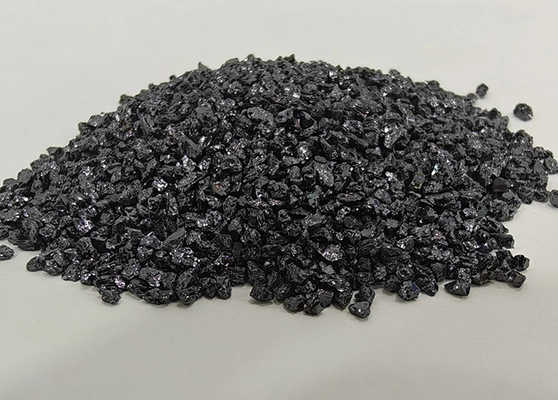Brown Fused Alumina (BFA) is a high-hardness abrasive material produced by melting bauxite in an electric arc furnace. This process creates a durable product widely used across various industries due to its exceptional toughness and versatility.
As a key player in the abrasives market, BFA stands out for its applications in grinding, blasting, and refractory manufacturing. Its importance stems from its ability to deliver reliable performance in demanding environments, making it essential for B2B operations in foreign trade and industrial supply chains.
Originating from high-quality bauxite, BFA's production involves intense heat to form a crystalline structure that enhances its abrasive properties. This article explores its key characteristics, helping professionals in the foreign trade sector understand how to leverage BFA for optimal results.
Basic Physical and Chemical Properties
Understanding the properties of Brown Fused Alumina is crucial for selecting the right material in industrial applications. One of its standout features is its hardness, rated at approximately 9 on the Mohs scale, which makes it ideal for heavy-duty abrasion tasks.
Chemically, BFA consists of about 95% aluminum oxide (Al₂O₃), with minor impurities such as titanium dioxide (TiO₂) and iron oxide (Fe₂O₃). These elements contribute to its unique balance of strength and toughness without compromising performance.
The melting point of BFA is around 2,050°C, allowing it to withstand extreme temperatures in refractory uses. Additionally, its density typically ranges from 3.9 to 4.1 g/cm³, providing excellent wear resistance that extends the lifespan of tools and equipment.
Due to its high durability, BFA exhibits superior resistance to thermal shock and chemical corrosion, making it a preferred choice for environments exposed to harsh conditions. These properties ensure consistent performance in high-stress applications.
Manufacturing Process
The production of Brown Fused Alumina begins with high-grade bauxite as the primary raw material. This ore is melted in an electric arc furnace at temperatures exceeding 2,000°C, fusing the components into a homogeneous mass.
After melting, the material undergoes rapid cooling to form solid blocks, which are then crushed and graded into various particle sizes. This process ensures uniformity, allowing BFA to meet specific industry standards for abrasives and refractories.
In comparison, White Fused Alumina is manufactured using a purer form of alumina with less impurities, resulting in a higher purity product. However, BFA's process incorporates more cost-effective raw materials, making it more accessible for bulk applications while still delivering strong performance.
This manufacturing difference affects the final product's color and toughness; BFA has a brownish tint due to iron content, whereas White Fused Alumina appears whiter and is often chosen for precision work. Understanding these variations helps buyers in foreign trade select the best option for their needs.
Application Areas
Brown Fused Alumina excels in grinding tools such as grinding wheels, belts, and papers, where its hardness enables efficient material removal on metals and ceramics. Its toughness ensures minimal fracturing during use, extending tool life.
In sandblasting and surface treatment, BFA is valued for its ability to clean and etch surfaces without causing excessive damage. This makes it popular in automotive, aerospace, and construction industries for preparing materials for coating or finishing.
For refractory materials, BFA serves as a key ingredient in castables and bricks, providing high thermal stability and resistance to slag. These properties are essential in furnaces, kilns, and other high-temperature environments in steel and glass production.
Other industrial uses include precision lapping, polishing, and even water jet cutting, where BFA's consistent particle size and durability enhance efficiency. In B2B contexts, its versatility supports global supply chains for manufacturing and export.
Comparison Analysis
When comparing Brown Fused Alumina to White Fused Alumina, key differences emerge in durability, cost, and purity. BFA offers greater toughness due to its iron content, making it more resistant to fracturing in heavy abrasive applications.
In terms of cost, BFA is generally more economical because it uses readily available bauxite with impurities, whereas White Fused Alumina requires higher-purity alumina, increasing production expenses. This makes BFA a cost-effective choice for large-scale operations.
Purity levels are another factor; White Fused Alumina has a higher Al₂O₃ content (over 99%), resulting in a cleaner finish for sensitive applications like electronics. Conversely, BFA's slightly lower purity suits it for robust tasks where minor impurities do not impact performance.
Overall, BFA provides better value for durability-focused industries, while White Fused Alumina is preferred for high-precision needs. For more detailed insights, we recommend visiting our subpages on Brown Alumina, Brown Fused Alumina, and White Fused Alumina to explore product specifications and supplier options.
FAQ
What is Brown Fused Alumina and how is it made? Brown Fused Alumina is a synthetic abrasive created by melting bauxite in an electric arc furnace. The process results in a hard, durable material used for grinding and blasting.
What are the main properties that make BFA suitable for abrasives? Key properties include a Mohs hardness of 9, high density around 4.0 g/cm³, and excellent wear resistance, which allow it to perform effectively in tough industrial environments.
How does Brown Fused Alumina compare to other abrasives in cost? BFA is more affordable than purer options like White Fused Alumina due to its raw material composition, making it ideal for budget-conscious B2B applications without sacrificing quality.
What industries benefit most from using BFA in refractories? Industries such as steel, ceramics, and glass manufacturing rely on BFA for its thermal stability and resistance to high temperatures in refractory bricks and castables.
Can Brown Fused Alumina be used for precision applications? While BFA is versatile, its slight impurities make it better for general abrasion rather than ultra-precision tasks, where White Fused Alumina might be more appropriate.
Conclusion
In summary, Brown Fused Alumina's core properties—such as its high hardness, chemical composition, and manufacturing efficiency—make it an indispensable material in abrasives, refractories, and surface treatment. Its durability and cost-effectiveness provide significant value for B2B professionals in foreign trade.
Request a Quote or Sample
Popular Products
Grünes Siliziumkarbid
View DetailsSchwarzes Siliziumkarbid
View Details